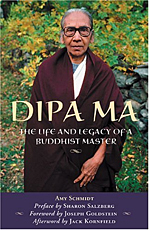Dipa Ma Bura, who died in 1989 at the age of 78, was the first truly accomplished meditation master in the Theravada tradition to teach in America. Among her devoted students were Jack Kornfield, Sharon Salzberg, and Joseph Goldstein — all members of the Insight Mediation Society. In this presentation of the life and teachings of Dipa Ma, Amy Schmidt has gathered many quotations and anecdotes that reveal the startling presence and many spiritual gifts of this diminutive woman. These tributes come from her American and Calcutta students and from some family members.
In the foreword, Joseph Goldstein recalls the special quality of her being that touched those who met her: "It was a quality of the quietest peace fully suffused with love. This stillness and love were different from anything I had encountered before. They were not an ego persona, and they didn't want or need anything in return. Simply, in the absence of self, love and peace were what remained."
Dipa Ma was born and raised in India and sent off to be married to a 45-year-old man when she was 12 years old. When that relationship didn't work, she went to Burma to live with another man. At 18, Dipa Ma had a premonitory dream of her mother's death which turned out to be true.
Her husband left her a widow with a 7-year-old daughter to raise. In her forties and depressed, she had a dream in which Buddha appeared to her, and her life was turned around. With her great powers of concentration, she became a meditation master. In Calcutta, she taught this spiritual practice to householders. "The whole path of mindfulness is this: Whatever you are doing, be aware of it." Under this rubric, ironing, cooking, and any daily activity could be done with attention. Dipa Ma's other spiritual gifts included the practices of dematerialization, body-doubling, cooking food without fire, mind-reading, time travel, and knowledge of past lives. These abilities have been identified and acknowledged in other yogis and shamans.
Jack Engler gives this account of his deep appreciation of her spirituality: "When she first moved into her apartment complex, it was a pretty noisy and contentious place, with a lot of bickering, arguing, and yelling among the tenants, amplified by the open courtyard. Everyone knew everyone else's business because it was being shouted back and forth all the time. Within six months of her moving in, the whole place had quieted down and people were starting to get along with each other for the first time. Her presence, and the way she dealt with people — quietly, calmly, gently, treating them with kindness and respect, setting limits and challenging their behavior when necessary but out of concern for everyone's welfare, not out of anger or simple desire for her personal comfort — set an example and made it impossible to carry on in the angry, contentious way they had before. It was the simple force of her presence: you couldn't act like that around her. You just didn't."
This portrait of the Buddhist master, previously released with the title Knee Deep in Grace, also contains some of the essentials of her teachings on seeing every situation as workable, practicing patience, not letting thoughts of the past or future to spoil time, and making one's life into one continuous blessing. Calling Dipa Ma "the patron saint of householders" has a ring of reality to it. Her mastery of meditation and her saintly presence both came to the fore in her small Calcutta apartment where the dharma was practiced day by day in the midst of a busy life.
